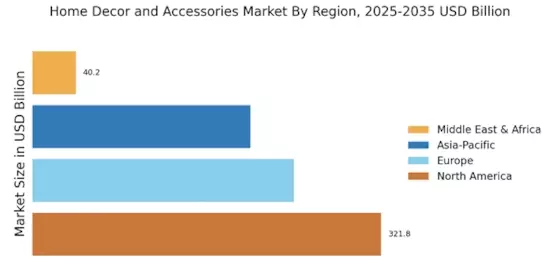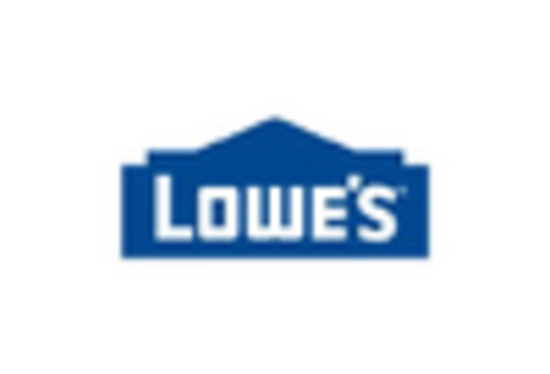The Home Decor and Accessories Market is currently characterized by a dynamic competitive landscape, driven by evolving consumer preferences and technological advancements. Key players such as IKEA (SE), Home Depot (US), and Wayfair (US) are strategically positioning themselves to capitalize on these trends. IKEA (SE) continues to emphasize sustainability and affordability, while Home Depot (US) focuses on enhancing its omnichannel capabilities to improve customer experience. Wayfair (US), on the other hand, leverages its extensive online platform to offer a vast selection of products, thereby catering to a diverse customer base. Collectively, these strategies not only enhance their market presence but also intensify competition, as each company seeks to differentiate itself through unique value propositions.
In terms of business tactics, companies are increasingly localizing manufacturing and optimizing supply chains to respond swiftly to market demands. The competitive structure of the market appears moderately fragmented, with several players vying for market share. This fragmentation allows for niche players to emerge, while larger companies leverage economies of scale to maintain their competitive edge. The collective influence of these key players shapes market dynamics, as they adapt to consumer trends and technological innovations.
In August 2025, IKEA (SE) announced the launch of a new line of eco-friendly home accessories, which underscores its commitment to sustainability. This strategic move not only aligns with global trends towards environmentally conscious products but also positions IKEA as a leader in sustainable home decor. By integrating sustainable materials into its product offerings, IKEA aims to attract a growing segment of eco-aware consumers, thereby enhancing its market share.
In September 2025, Home Depot (US) unveiled a new augmented reality (AR) feature on its mobile app, allowing customers to visualize products in their homes before making a purchase. This innovation reflects Home Depot's focus on digital transformation and customer engagement. By enhancing the shopping experience through technology, Home Depot is likely to increase customer satisfaction and drive sales, positioning itself favorably against competitors.
In October 2025, Wayfair (US) expanded its partnership with local artisans to offer exclusive, handcrafted home decor items. This initiative not only diversifies Wayfair's product range but also supports local economies and promotes unique, culturally rich products. By emphasizing local craftsmanship, Wayfair differentiates itself in a crowded market, appealing to consumers seeking authenticity and uniqueness in their home decor choices.
As of October 2025, the competitive trends in the Home Decor and Accessories Market are increasingly defined by digitalization, sustainability, and the integration of artificial intelligence. Strategic alliances among companies are shaping the landscape, as partnerships enable firms to enhance their product offerings and market reach. Looking ahead, competitive differentiation is likely to evolve from traditional price-based competition to a focus on innovation, technology integration, and supply chain reliability. Companies that can effectively leverage these trends will likely secure a stronger foothold in the market.


















Leave a Comment